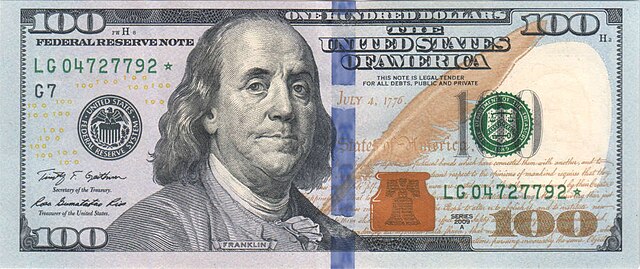100
Natural number From Wikipedia, the free encyclopedia
100 or one hundred (Roman numeral: C)[1] is the natural number following 99 and preceding 101.
| ||||
|---|---|---|---|---|
| Cardinal | one hundred | |||
| Ordinal | 100th (one hundredth) | |||
| Factorization | 22 × 52 | |||
| Divisors | 1, 2, 4, 5, 10, 20, 25, 50, 100 | |||
| Greek numeral | Ρ´ | |||
| Roman numeral | C, c | |||
| Binary | 11001002 | |||
| Ternary | 102013 | |||
| Senary | 2446 | |||
| Octal | 1448 | |||
| Duodecimal | 8412 | |||
| Hexadecimal | 6416 | |||
| Greek numeral | ρ | |||
| Arabic | ١٠٠ | |||
| Bengali | ১০০ | |||
| Chinese numeral | 佰,百 | |||
| Devanagari | १०० | |||
| Hebrew | ק | |||
| Khmer | ១០០ | |||
| Armenian | Ճ | |||
| Tamil | ௱, க௦௦ | |||
| Thai | ๑๐๐ | |||
| Egyptian hieroglyph | 𓍢 | |||
| Babylonian cuneiform | 𒐕𒐏 | |||
In mathematics
Summarize
Perspective

100 is the square of 10 (in scientific notation it is written as 102). The standard SI prefix for a hundred is "hecto-".
100 is the basis of percentages (per centum meaning "by the hundred" in Latin), with 100% being a full amount.
100 is a Harshad number in decimal, and also in base-four, a base in-which it is also a self-descriptive number.[2][3]
100 is the sum of the first nine prime numbers, from 2 through 23.[4] It is also divisible by the number of primes below it, 25.[5]
100 cannot be expressed as the difference between any integer and the total of coprimes below it, making it a noncototient.[6]
100 has a reduced totient of 20, and an Euler totient of 40.[7][8] A totient value of 100 is obtained from four numbers: 101, 125, 202, and 250.
100 can be expressed as a sum of some of its divisors, making it a semiperfect number.[9] The geometric mean of its nine divisors is 10.
100 is the sum of the cubes of the first four positive integers (100 = 13 + 23 + 33 + 43).[10] This is related by Nicomachus's theorem to the fact that 100 also equals the square of the sum of the first four positive integers: 100 = 102 = (1 + 2 + 3 + 4)2.[11]
100 = 26 + 62, thus 100 is the seventh Leyland number.[12] 100 is also the seventeenth Erdős–Woods number, and the fourth 18-gonal number.[13][14]
It is the 10th star number[15] (whose digit sum also adds to 10 in decimal).
In history
In money

Most of the world's currencies are divided into 100 subunits. For example, one euro is one hundred cents and one pound sterling is one hundred pence.
By specification, 100 euro notes feature a picture of a Rococo gateway on the obverse and a Baroque bridge on the reverse.

The United States one-hundred-dollar bill has Benjamin Franklin's portrait; this "Benjamin" is the largest American banknote in circulation.
In other fields
Computers & Software
- The HTTP status code indicating that the client should continue with its request.
- 100 Mbps Ethernet: Fast Ethernet standard.
Science & Measurement
- 100°C: The boiling point of water under standard atmospheric pressure.
- 100 centimetres = 1 meter: Used in metric measurements.
- 100 is the atomic number of Fermium (Fm): A synthetic chemical element in the periodic table.
Sports
- 100-meter sprint: One of the most prestigious Olympic events.
Culture
- 100 emoji 💯: Is commonly used to represent something excellent or perfect.
See also
References
External links
Wikiwand - on
Seamless Wikipedia browsing. On steroids.